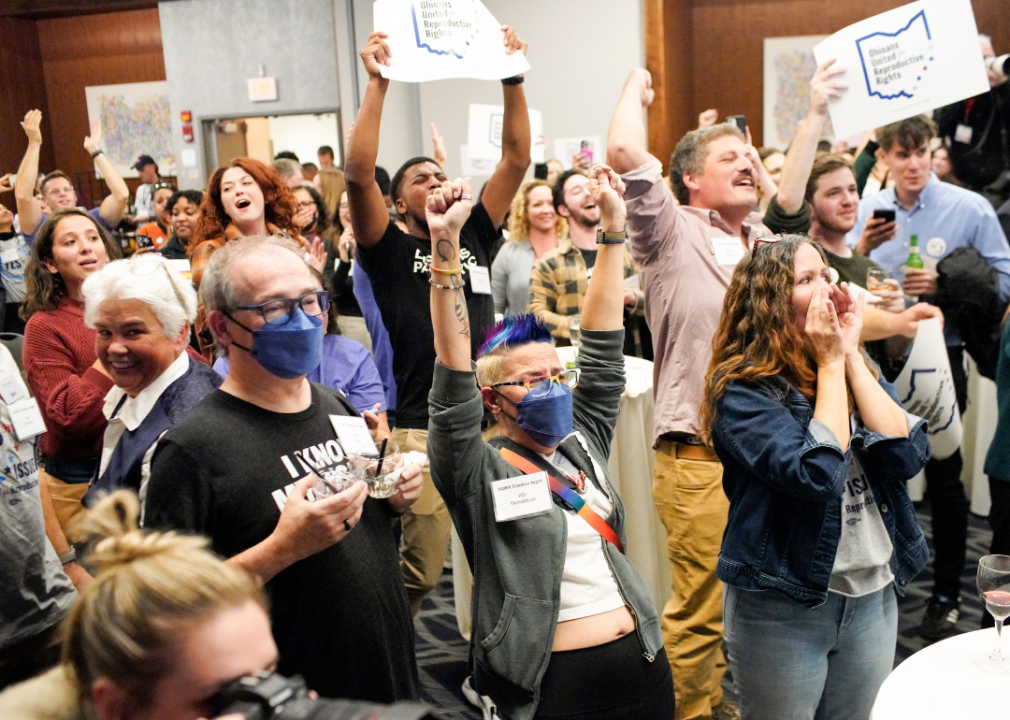Keystone/Hulton Archive // Getty Images; Bob Riha, Jr. // Getty Images; OLIVIER DOULIERY/AFP via Getty Images Protest is as American as apple pie–and the road to women’s equality has been paved with frequent acts of civil disobedience and everyday rebellions. Boycotts, public demonstrations, and other forms of protest have been used from time immemorial to further a myriad of causes and have often served to pressure legislators to adopt more progressive policies. Whether abolishing slavery, passing more just labor laws, affording all American adults the right to vote regardless of race or gender, or calling an end to an unjust war, protest at home and abroad has been central to society’s advances. When it comes to the use of protest to push for full gender equality, central is the fight over bodily autonomy; namely, the right for a pregnant person to choose whether to continue that pregnancy or legally and safely terminate it. Stacker put together a slideshow of 20 photos illustrating the history of reproductive rights protests from 1970 through today. The landmark 1973 Supreme Court decision in Roe v. Wade rendered criminal abortion bans unconstitutional. In so doing, the ruling cemented access to legal and safe abortions in the United States and fundamentally protected the right to choose for pregnant people, consecrating national values pertaining to rights to privacy, women’s ability to control their own bodies, and foundational American concepts of equality and independence. Prior to Roe, abortions were outlawed in 33 states; in 13 others, the termination of pregnancies was only permissible in special circumstances. Underscoring the reality of unintended pregnancies, researchers from Princeton University in the 1960s estimated that nearly 1 in 3 Americans not desiring more children were likely to have at least one unintended pregnancy before the end of their childbearing years. Further, more than 6 in 10 Americans who eventually wanted children were likely to have experienced at least one unintended pregnancy in their lives. Since the Supreme Court overturned Roe v. Wade in its 2022 decision in Dobbs v. Jackson Women’s Health Organization, 21 states banned abortion or limited its access to a narrower window of time than that established by Roe v. Wade. Keep reading to learn more about the fight for reproductive rights from 1970 through today. Aug. 26, 1970: Women’s Strike for Equality in NYC Bob Parent // Getty Images The Women’s Strike For Equality, which featured a march down Fifth Avenue in New York City, was organized by the National Organization for Women to proclaim that “women do not yet have the full freedom and equal status that is their birthright as human beings.” The event also marked the 50th anniversary of the 19th Amendment’s ratification and advocated for federally secured legal abortions, workplace equality, and free child care. Nov. 20, 1970: Pro-choice demonstration in Washington D.C. Leif Skoogfors // Getty Images In this photo, pro-choice demonstrators march with signs on Pennsylvania Avenue in Washington D.C. One of the signs reads “Defend Shirley Wheeler,” referencing the first woman prosecuted under Florida’s abortion laws, and among the first in the country, for having an illegal abortion. Wheeler was convicted the following year. March 8, 1975: International Women’s Day Bettmann Archive // Getty Images International Women’s Day was first observed in the early 1900s when 15,000 women in 1908 marched through New York City demanding equal rights. The United Nations officially marked the day in 1975; that year’s event brought together famous activists to advocate for women’s rights. This photo shows feminist Gloria Steinem chatting with marchers and reporters ahead of the event’s march, which commenced in Midtown Manhattan. About 2,000 women from all walks of life joined the solidarity march to advocate for full economic, political, legal, sexual, and racial equality and bodily autonomy. June 18, 1979: Pro-choice rally in Boston George Rizer // The Boston Globe via Getty Images Demonstrators in this photograph stand on the Massachusetts State House steps during a pro-choice rally in Boston. Members of the National Abortion Rights Action League hold a sign reading “KEEP ABORTION SAFE AND LEGAL.” Aug. 10, 1980: People’s Convention in NYC Barbara Alper // Getty Images Members of the Committee for Abortion Rights and Against Sterilization take part in a People’s Convention in New York City, just before the start of the Democratic National Convention on Aug. 11, 1980, which nominated President Jimmy Carter and Vice President Walter Mondale for reelection. Republican Ronald Reagan, the former actor and California governor who had strong antiabortion views, won in a landslide over Carter. July 9, 1989: Rally against anti-abortion violence Stephen J. Boitano/LightRocket via Getty Images Seven organizing groups spent more than a year planning the 2004 March for Women’s Lives. The effort inspired more than 1 million people from all over the country to descend on Washington D.C. to demonstrate in support of abortion rights, birth control, and unfettered access to healthy reproductive health care options. March 2, 2016: Toe-to-toe at Supreme Court Drew Angerer // Getty Images Pro-choice advocates, at right, and antiabortion advocates, at left, gathered outside the Supreme Court on March 2, 2016, in Washington D.C. ahead of the justices that morning hearing oral arguments in the Whole Woman’s Health v. Hellerstedt case. That case asked justices to consider the constitutionality of a law, Texas House Bill 2, with abortion-related provisions, including requiring physicians who perform abortions to have admitting privileges at a hospital within 30 miles of the abortion location; another provision required abortion clinics to be in compliance with standards set for ambulatory surgical centers. The court determined Texas HB 2 to be unconstitutional for imposing an outsized burden on women seeking legal abortions. Jan. 21, 2017: Making HERstory Mario Tama // Getty Images One day after President Donald Trump’s inauguration in January 2017, the largest single-day protest in American history took place as more than 500,000 people arrived in Washington D.C. for the Women’s March on Washington, and hundreds of thousands more took part in sister marches around the U.S. and world. In this photo, protesters are seen walking with the U.S. Capitol in the background. May 21, 2019: US rallies protest new, restrictive abortion laws Elijah Nouvelage // Getty Images In this photo, Georgia State Rep. Erica Thomas speaks at the Georgia State Capitol building during a protest against recently passed abortion ban bills. One bill, Georgia House Bill 481, also known as the state’s “heartbeat bill,” was signed into law to ban abortions once a fetal heartbeat is detected at six weeks of gestation. The other, the Human Life Protection Act, was signed into Alabama law by Gov. Kay Ivey on May 15, 2019. That bill, which banned virtually all abortions in the state, included no exceptions for cases of rape and incest, and outlawed all abortions except when necessary to prevent serious health problems for the woman. Under the law, a doctor performing an illegal abortion in Alabama would be guilty of a Class A felony and could face life imprisonment. The Human Life Protection Act was set to go into effect in November 2019 but was delayed by legal challenges. Meanwhile, Georgia House Bill 481 was ruled unconstitutional in July 2020. After Roe v. Wade was overturned in June 2022, both laws went into effect: The Georgia House Bill ruling was reversed and an Alabama judge lifted the injunction on that state’s abortion ban. May 11, 2022: ‘Never again!’ STEFANI REYNOLDS/AFP via Getty Images A draft opinion overturning Roe v. Wade and signed by Supreme Court Justice Samuel Alito was leaked on May 2, 2022, to massive public outcry and media attention. Just over a week later, Senate Democrats were unsuccessful in passing legislation to codify Roe v. Wade. In this photo, a pro-choice demonstrator holds a sign featuring a coat hanger, a symbol of the reproductive rights movement, with the words “NEVER AGAIN!” in front of the Supreme Court in Washington D.C. June 24, 2022: Supreme Court overturns Roe v. Wade
20 photos of reproductive rights protests from the age of Roe up until now















